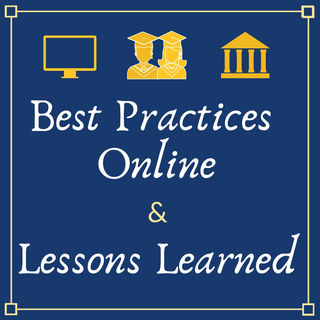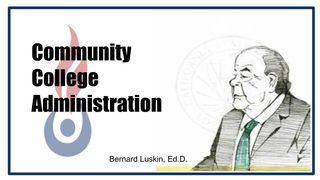Education
12 Best Practices in Online Teaching and Learning
Improving doctoral education online.
Posted March 2, 2019 Reviewed by Ekua Hagan

Luskin Learning Psychology Series, No. 44
Recently, I participated in the annual Faculty Convening of CODEL (Cooperative Online Doctorate in Educational Leadership) doctoral program. CODEL is a partnership doctoral program offered by California State University Channel Islands and CSU Fresno. Twenty-five faculty members and administrators teaching in the Ed.D. program gathered to share best practices in online teaching and learning.
The coursework in this program is fully online. During the program, five faculty members shared their best practices. Dr. Lorna Gonzalez, Instructional Designer for CODEL, assisted me in preparing my specialty course in Community College Leadership and Administration, available to year-3 doctoral candidates in the final academic term of the program before they are graduated. I approached teaching this specialty course in Community College Leadership and Administration as a research project and am reporting my results and experience in this article.
Overview
Last spring, I taught the same course in Community College Leadership and Administration, face-to-face, for California State University at Los Angeles with the intent of teaching then lifting and shifting this same course online for California State University, Channel Islands. I had been asked by CSUCI to teach this course online in spring 2019 for CSU CODEL. This gave me the opportunity to develop a face-to-face, classroom course and then transition that face-to-face course online.
Managing the sequence as a research project, I worked on the online course design for approximately one year. Spring 2019 was the first time this course had been taught fully online among any of the fifteen branches of the California State University system offering EdD programs. The CODEL EdD program coursework is now fully online.
I originally thought, after teaching the course face-to-face, that it would transfer smoothly online. The content in both courses was the same. However, that was not the case. The online course required a flipped-classroom design[1], different and modified from the original linear series of classroom presentations. As part of our plan, we identified adaptive techniques, some of which turned out to be, best practices.
My purpose in this article is to share insights from the migration of this Leadership and Administration course from a traditional classroom to an online experience and report some of the best practices that we validated through careful comparison. Both the face-to-face and the online offerings were quite successful and student feedback has been very positive. I have learned a great deal worth sharing.

Both teaching and learning in this online flipped-class format were significantly different from the traditional face-to-face class. As Lorna Gonzalez and I thoughtfully adapted the course for online delivery we realized that there is a significant difference between delivering a course and accessing instructions and content. We kept the instructions very clear as we included them within our Canvas Learning Management System (LMS). In addition, every Monday I emailed all students an update reminder of the next week’s requirements as they progressed through the course.
[1] Operational Definition: “Flipped-Classroom” is now a common term. For my purpose in this article, a flipped-classroom is defined as learning the basic content (recorded lectures, readings and other research) taking place outside the “zoom sessions” that are reserved solely for “live,” face-to-face discussions between all the students and their professor.
Online Courses and Graduate Degree Programs Are Evolving
Though there is a long history of online courses, increased knowledge about learning related to media psychology, advancing technology (including rapidly improving Learning Management Systems, such as Canvas) and the growing ranks of individuals with the highly-developed knowledge and skills to move this field forward are now advanced and positioned to dramatically elevate today’s online courses to a very effective and successful level. The lack of individuals with necessary component skills, available technology, and student receptivity are no longer critical obstacles to progress… they are propellants.
Online courses and program offerings are increasing worldwide. The reality is that “distance is dead” or dying in the few outposts where boundaries or other impediments still remain to be overcome. The integration of blended and online courses and programs is a way of the future. The 21st-century online course has now completely eclipsed the electronic courses of the past century. The enthusiastic faculty sharing experiences at the CODEL annual conference is a model of sharing and evaluating best practices in this new educational frontier.
Following are 12 best practices, informed by my years of training and practice in psychology and education, coupled with contemporary research in online teaching and learning. My experience and intentional treatment of the course development as a research project were significant factors in creating and teaching this course successfully online.
12 Online Best Practices in Community College Leadership and Administration
1. The Cohort Model works well in specific circumstances. It enables students to know each other and progress together. The Cohort Model creates a community of shared interest and community of practice. Research shows that students do best when they know each other.
2. Focus on "Active" Learning. The course mixed spurts of discussion, collaboration, video and audio clips, hands-on exercises with text, and brief video lectures. The entire experience was approached by all as an active learning online course.
3. Organize the Lessons Topically in Modules. Keeping each student engaged was a major objective. Designing communications in 10 to 15 minute “chunks” was important. Also, varying the format and varying the choices in student response options offered in the Canvas learning environment enabled typed, spoken or video responses. Attention is a limited resource and the variety and options available invigorated the students’ learning process.
4. Clear assignments and deadlines are essential. Straightforward communication of what is expected and the timelines for completion are important.
5. Being physically and mentally present makes a difference. Ideally, faculty members online are the “guide on the side.” Faculty members are coaches. Being mentally present, paying attention, and being fully engaged with the students are the most important practices the teacher can embrace. Being remote, reserved or unavailable causes an unsatisfactory student experience.
Research shows that the “sage on the stage” is best when blended as the “guide on the side." An effective guide on the side makes a measurable, positive difference in student engagement, attention, learning and satisfaction. Perfecting the "guide on side" techniques is one of the features that is more prominent and necessary for effective progress in online courses. While the content may be the same, the methodology in online and face-to-face classroom classes is significantly different. The messages remain the same while the message of the content is quite different.
6. Instructor presence is critical. All those queried agreed that active faculty presence is critical to student success in a virtual class environment. Today’s online courses are rigorous, demanding and require attention and engagement.
7. Respond selectively and effectively. Thoughtful personal responses have a positive effect. They humanize the online learning experience for both the faculty and the students.
8. Multiple means of engagement enhance the connection of the learner to the course objectives and facilitate the learning experience. To do this, I leveraged a variety of available tools, including typed responses, VoiceThread, Personalized Video Clips and more.
9. Scheduled weekly sessions work. Providing an asynchronous content research and learning pattern, paired with synchronous sessions for cohort discussions, were successful. Students reported positively on their experiences. We met in a Zoom Session, as a class, for 90 minutes once each week throughout the course.
10. Easy access and frequent contact with faculty members make a big difference. “Removing the desk,” i.e., making it easy to contact faculty is very important to student success. The faculty-student relationship is critical to humanizing the teaching and learning experience.

11. Easy-to-follow course design is important. In this course, the subject matter was divided into 40 topics and assigned, for presentation purposes, among individual students. Each student researched, posted and led a discussion on two topics scheduled over eight weeks. Each week was topically separated. Selected students posted their assigned Topic Talking Points on Sunday evening, and then all students read each topic and commented on the online discussion board on Monday, Tuesday, and Wednesday. A 90-minute Zoom Session was scheduled each Wednesday evening for 3 to 5 topic presentations. Post the Zoom Session on Wednesdays, each student exchanged after-action comments during the rest of the week. The following Sunday, 3-5 new topics were posted and the format was repeated. Feedback from students was very positive. This description describes what has been termed in this article as the “flipped-class.”
12. Talking Points, Elevator Speech and Nutshell Essay methods are effective techniques. As noted earlier, Nutshell Essays, Talking Points, Elevator Speech, or whatever one chooses to call them, are the subject of each week’s study as described in 11 above. This format works in courses such as leadership, administration and management, chemistry, mathematics, psychology and many more where topics and fundamentals can be specifically identified and shared.
Conclusions
Best practices in teaching and learning include a stream of defining moments and epiphanies that may be effectively offered online. Teaching includes inspiring one’s students. One critical key to success in online courses is having easy access to faculty. A principal objective is to create conditions that allow students to flourish and where the environment is as personalized as possible. Almost every education system in the world is now being reformed. Perfecting successful online courses and program offerings is a big part of this process of change and reform that is the future of education.
This summary reviews twelve best practices that were successful in my recent course in Community College Leadership and Administration in the CODEL program. Feedback on the course was excellent. My hope is that research on best practices will continue and be increasingly shared as an approach to continuous improvement. My view is that our future in education is changing and bright. Online and blended learning will continue to successfully expand. Through working together and sharing our experiences we can continue to make progress by regularly asking ourselves the question:
“What needs to change and What needs to remain the same?”
###
Special Thanks: Dr. Lorna Gonzalez, CODEL Instructional Designer, for assistance with course design, identification of best practices and editing and Dr. Toni Luskin for editing and assistance in posting this article.
References
McKlenny, K. (2019). Community College Center for the Study of Student Engagement, University of Texas, Austin.
Porter, S.R. and Umbach, P.D. (2019). What challenges to success do community college students face? Raleigh, NC: Percontor, LLC.




